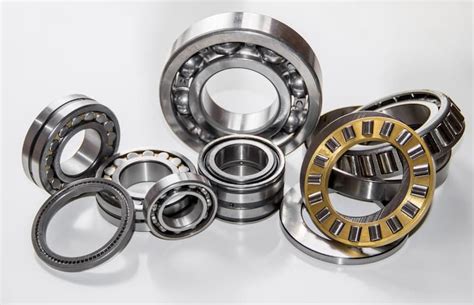Understanding Bearings: A Comprehensive Guide
What is a Bearing?
A bearing is a mechanical device that supports and reduces friction between rotating or sliding surfaces. It consists of two main components: a raceway and a rolling element. The raceway is a stationary surface that guides the rolling element, while the rolling element is a movable part that rotates or slides between the raceways.
Types of Bearings
There are many different types of bearings, each with its own unique characteristics and applications. The most common types of bearings include:
-
Ball bearings: Ball bearings use balls as the rolling element. They are the most widely used type of bearing due to their low friction and high speed capability.
-
Roller bearings: Roller bearings use rollers as the rolling element. They are typically more durable and can handle heavier loads than ball bearings, but they also have higher friction.
-
Needle bearings: Needle bearings use needle rollers as the rolling element. They are very compact and can handle high loads in a small space.
-
Thrust bearings: Thrust bearings are designed to handle axial loads (loads applied perpendicular to the shaft). They are commonly used in applications such as propellers and pumps.
Importance of Bearings
Bearings play a critical role in many mechanical systems. They reduce friction, which can improve efficiency and extend the life of the system. They also support loads and prevent misalignment, which can cause damage to the system.

The use of bearings has led to significant improvements in the performance and reliability of a wide range of machines and devices, including:
- Automobiles
- Aircraft
- Industrial machinery
- Power tools
- Medical equipment
Benefits of Bearings
The use of bearings provides several benefits, including:

- Reduced friction
- Increased efficiency
- Longer system life
- Improved reliability
- Reduced noise and vibration
- Lower maintenance costs
Pros and Cons of Different Bearing Types
Each type of bearing has its own advantages and disadvantages. The following table compares the pros and cons of the most common types of bearings:
| Bearing Type |
Pros |
Cons |
| Ball bearings |
Low friction, high speed capability |
Lower load capacity than roller bearings |
| Roller bearings |
Higher load capacity, more durable |
Higher friction than ball bearings |
| Needle bearings |
Compact, high load capacity |
Sensitive to misalignment |
| Thrust bearings |
Designed for axial loads |
Not suitable for radial loads |
How to Choose the Right Bearing for Your Application
When choosing a bearing for your application, it is important to consider the following factors:

-
Load: The load that the bearing will be subjected to.
-
Speed: The speed at which the bearing will be operating.
-
Environment: The environment in which the bearing will be used (e.g., temperature, humidity, chemicals).
-
Cost: The cost of the bearing.
Once you have considered these factors, you can use the following table to help you choose the right bearing for your application:
| Application |
Bearing Type |
| Low load, low speed |
Ball bearings |
| High load, low speed |
Roller bearings |
| High load, high speed |
Needle bearings |
|
Axial loads |
Thrust bearings |
Step-by-Step Approach to Installing a Bearing
Installing a bearing correctly is essential to ensure its proper function and longevity. The following is a step-by-step approach to installing a bearing:
-
Prepare the bearing: Remove the bearing from its packaging and inspect it for any damage.
-
Prepare the housing: Clean the bearing housing and apply a thin layer of lubricant.
-
Insert the bearing: Carefully insert the bearing into the housing.
-
Secure the bearing: Use a retaining ring or other method to secure the bearing in place.
-
Lubricate the bearing: Apply a sufficient amount of lubricant to the bearing.
-
Test the bearing: Rotate the bearing by hand to ensure it is functioning properly.
Common Mistakes to Avoid
When installing a bearing, it is important to avoid the following common mistakes:
-
Overtightening: Overtightening the bearing can damage the bearing and its housing.
-
Undertightening: Undertightening the bearing can cause it to slip or become misaligned.
-
Using the wrong type of lubricant: Using the wrong type of lubricant can damage the bearing.
-
Not lubricating the bearing: Failing to lubricate the bearing can cause it to fail prematurely.
-
Installing the bearing in a dirty or contaminated environment: Installing the bearing in a dirty or contaminated environment can damage the bearing and its housing.
FAQs
-
What is the difference between a bearing and a bushing?
A bearing is a mechanical device that supports and reduces friction between rotating or sliding surfaces. A bushing is a type of bearing that is used to reduce friction between two sliding surfaces.

-
What is the purpose of a bearing seal?
A bearing seal is a device that is used to prevent contaminants from entering the bearing.
-
How often should a bearing be lubricated?
The frequency of lubrication depends on the type of bearing, the operating conditions, and the manufacturer's recommendations.
-
What are the signs of a failing bearing?
Signs of a failing bearing include:
- Noise
- Vibration
- Heat
- Loss of lubrication
-
How can I extend the life of a bearing?
You can extend the life of a bearing by:
- Lubricating it regularly.
- Protecting it from contaminants.
- Avoiding overloading it.
- Inspecting it regularly for signs of wear or damage.
-
Where can I find more information about bearings?
You can find more information about bearings from the following sources:
- The Bearing Manufacturers' Association (BMA)
- The American Bearing Manufacturers' Association (ABMA)
- The Society of Tribologists and Lubrication Engineers (STLE)
- The National Lubricating Grease Institute (NLGI)

